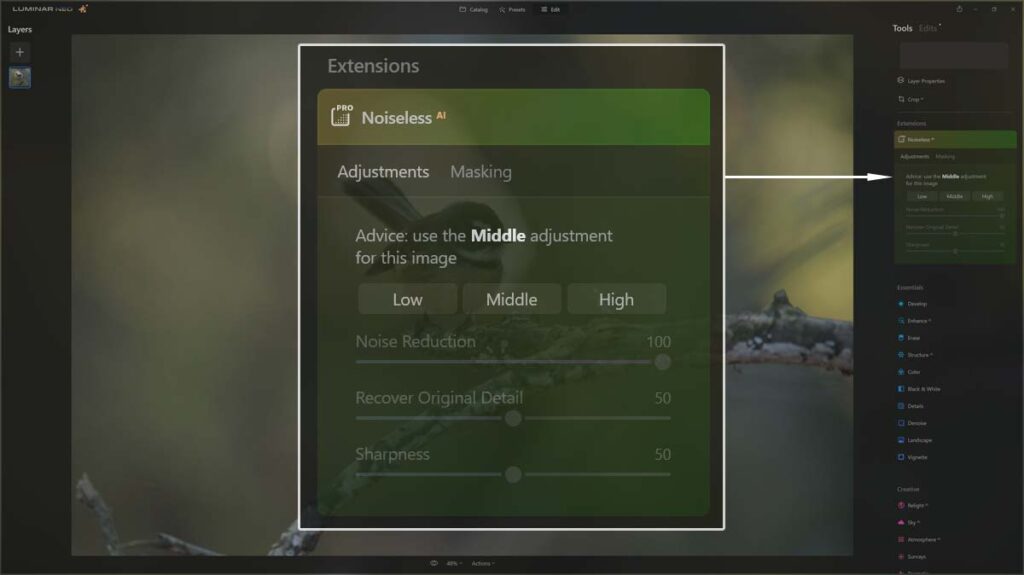

We can try to fix that using the “edge correction” slider, which will help the image a little bit, but what we can do now is use the brush tool to fix them. In this example, if I increase the amount of Bokeh, you will see that Luminar has missed some areas If you hover over the canvas, you will see a preview of the mask that Luminar created, and you can use the brush tool to paint on top of this mask, In Luminar Neo they introduced the layers feature, so if you close the tab of any particular feature, and then reopen it again, you will see that all the settings will be reset, that’s because it’s now moved under the “edits” section, and there you can continue making changes to the features you appliedĪnd you can also stack them on top of each other, and you even have the ability to stack multiple layers of the same effect.

Quick Tip: you can toggle the before and after preview using the backslash key \ on your keyboard, and you can also control the visibility of the individual features by clicking on the eye icon. You also have the edge correction slider, which will help you fix the edges of details like hair. You can also do some changes to the background by expanding the background section, and from there, you can control the depth of the blur by decreasing the “Depth Correction” slider, and as you can see, the blur depth is now much closer to the foreground. Portrait Bokeh is a feature that’s been in Luminar Ai for quite some time, and it’s also available in Luminar Neo, you can find it under the portrait section, click on it to expand it, and then all you have to do is to increase the amount to blur the background.Īs you can see the subject was automatically masked out and the background is blurred. Starting with the first feature in this list which is “portrait Bokeh”. Whether you are an existing user of Luminar Ai or completely new to Skylum Software, this video will give you a better look at Luminar Neo and help you decide if it is for you. Today, I’m going to show you the best 6 Luminar Neo features that will make your photo editing workflow so much faster and easier.
Luminar neo masking software#
The AI also detects different types of lines and removes them with one click.Luminar Ai was a great software and such a time saver for many people with features like sky replacement, portrait bokeh, retouching, and more, and with the introduction of their new software Luminar Neo, they introduced many new improvements as well as new features The Dust Spot Removal tool can even be used to edit images where dirt, sand or dust has gotten onto the sensor during the photo session. This opens up immense possibilities, from reducing edge lighting to imitating studio light. It calculates the depth of a photo and creates a depth map to spatially distribute light across a 2D image. Sky and water can also be masked simultaneously to unify color harmonies and add even more contrast. Also improved is the RelightAI tool in Luminar Neo, which works like a virtual flash for close-up portraits or group photos at events. The Enhance AI tool, for example, can be used to add accents of color, detail, depth, and tone to selected parts of the image. The Mask AI also allows you to select different objects and edit them at the same time. The artificial intelligence is so precise that it not only selects the main subject, but even distinguishes between pavement and soil. The variety of objects that can be masked with one click goes beyond people in Luminar Neo, allowing masks to be automatically created for buildings, skies, vehicles, water, mountains, and soils as well. The background removal process must first be selected, so the Portrait Background Removal tool can be found in Luminar Neo Layer's masking options. With the Portrait Background Removal feature, a slider can be used to select an object and remove the background behind it. Thanks to AI, the latest tool in Luminar Neo offers the highest accuracy.
Luminar neo masking manual#
The results appear unrealistic and after the automated, another manual processing follows. Automated, web-based editing tools often do not provide the desired quality, because the selection and object detection are rather superficial.


 0 kommentar(er)
0 kommentar(er)
